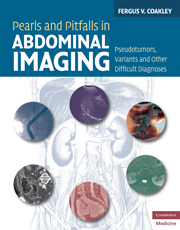Book contents
- Frontmatter
- Contents
- Preface
- Acknowledgements
- Section 1 Diaphragm and adjacent structures
- Section 2 Liver
- Section 3 Biliary system
- Section 4 Spleen
- Section 5 Pancreas
- Section 6 Adrenal glands
- Section 7 Kidneys
- Section 8 Retroperitoneum
- Section 9 Gastrointestinal tract
- Section 10 Peritoneal cavity
- Case 68 Pseudoabscess due to absorbable hemostatic sponge
- Case 69 Pseudoperforation due to enhancing ascites
- Case 70 Pseudomyxoma peritonei
- Case 71 Gossypiboma
- Section 11 Ovaries
- Section 12 Uterus and vagina
- Section 13 Bladder
- Section 14 Pelvic soft tissues
- Section 15 Groin
- Section 16 Bone
- Index
- References
Case 70 - Pseudomyxoma peritonei
from Section 10 - Peritoneal cavity
Published online by Cambridge University Press: 05 November 2011
- Frontmatter
- Contents
- Preface
- Acknowledgements
- Section 1 Diaphragm and adjacent structures
- Section 2 Liver
- Section 3 Biliary system
- Section 4 Spleen
- Section 5 Pancreas
- Section 6 Adrenal glands
- Section 7 Kidneys
- Section 8 Retroperitoneum
- Section 9 Gastrointestinal tract
- Section 10 Peritoneal cavity
- Case 68 Pseudoabscess due to absorbable hemostatic sponge
- Case 69 Pseudoperforation due to enhancing ascites
- Case 70 Pseudomyxoma peritonei
- Case 71 Gossypiboma
- Section 11 Ovaries
- Section 12 Uterus and vagina
- Section 13 Bladder
- Section 14 Pelvic soft tissues
- Section 15 Groin
- Section 16 Bone
- Index
- References
Summary
Imaging description
Pseudomyxoma peritonei (colloquially but aptly called “jelly-belly”) refers to the progressive accumulation of copious, thick, mucinous or gelatinous material in the peritoneal cavity, and as such is a morphological description rather than a specific pathological diagnosis [1]. The mucin is produced by mucinous tumor cells in the peritoneal cavity, believed to arise from rupture of an intra-abdominal mucinous tumor, usually of the appendix or ovary [2]. Imaging findings that suggest pseudomyxoma peritonei include ascitic fluid that contains non-mobile echoes or septations at ultrasound or is slightly above simple fluid density at CT, or that produces masslike changes on the intraperitoneal contents at cross-sectional imaging, particularly scalloping of the hepatic and splenic margins (Figures 70.1–70.3)[2–5]. Occasionally, faint, curvilinear, or amorphous calcifications may be visible [2].
Importance
While pseudomyxoma peritonei is a rare condition, it is important to recognize and distinguish it from simple ascites and standard peritoneal carcinomatosis. While a primary site in the appendix or ovary is the presumed etiology in most cases, a primary tumor is usually not separately identifiable by the time of diagnosis [6]. Sometimes both the appendix and ovaries are involved, and some believe that the ovarian tumors are then metastases from the appendix, whereas others do not [7, 8]. Independent of these considerations, the appendix and ovaries should be closely inspected in all newly diagnosed cases.
Typical clinical scenario
The incidence of pseudomyxoma peritonei is one per million population per year [9], with a mean age at diagnosis of 49 years (range 23 to 83) [10]. Common presenting symptoms are progressive painful abdominal distension and weight loss.
Information
- Type
- Chapter
- Information
- Pearls and Pitfalls in Abdominal ImagingPseudotumors, Variants and Other Difficult Diagnoses, pp. 234 - 237Publisher: Cambridge University PressPrint publication year: 2010
